Hatshepsut › Osiris » Ancient origins
Articles and Definitions › Contents
- Hatshepsut › Who Was
- Osiris › Who Was
Ancient civilizations › Historical and archaeological sites
Hatshepsut › Who Was
Definition and Origins
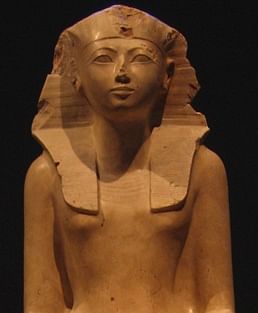
Hatshepsut (1479-1458 BCE) was the first female ruler of ancient Egypt to reign as a male with the full authority of pharaoh.Her name means "Foremost of Noble Women" or "She is First Among Noble Women". She began her reign as regent to her stepson Thuthmose III (1458-1425 BCE) who would succeed her and, initially, ruled as a woman as depicted in statuary. In around the seventh year of her reign, however, she chose to be depicted as a male pharaoh in statuary and reliefs though still referring to herself as female in her inscriptions. She was the fifth pharaoh of the 18th Dynasty during the period known as the New Kingdom (1570-1069 BCE) and regarded as one of the best.
Although she is sometimes cited as the first female ruler of Egypt, or the only one, there were women who reigned before her such as Merneith (c. 3000 BCE) in the Early Dynastic Period (probably as regent) and Sobeknefru (c. 1807-1802 BCE) in the Middle Kingdom and Twosret (1191-1190 BCE) after her toward the end of the 19th Dynasty. Hatshepsut, though not the first or last, is undoubtedly the best known female ruler of ancient Egypt after Cleopatra VII (c. 69-30 BCE) and one of the most successful monarchs in Egyptian history.
Historian Marc van de Mieroop expresses the conventional view of Hatshepsut when he notes how she "has become one of the most celebrated and controversial women of Egypt and the ancient world in general" (172). She is celebrated as a powerful female ruler whose reign was extremely successful and this is the same reason for the controversy: according to Egyptian tradition, no woman should have been able to assume the full power of pharaoh.
HATSHEPSUT "HAS BECOME ONE OF THE MOST CELEBRATED & CONTROVERSIAL WOMEN OF EGYPT & THE ANCIENT WORLD IN GENERAL" (VAN DE MIEROOP)
Further, her name was erased from her monuments following her death which strongly suggests that someone, most likely Thutmose III, wanted to remove all evidence of her from history. Later scribes never mention her and her many temples and monuments were often claimed to be the works of later pharaohs. Her existence only came to light fairly recently in history when the orientalist Jean-Francois Champollion (1790-1832 CE), most famous for deciphering the Rosetta Stone, found he could not reconcile hieroglyphics indicating a female ruler with statuary obviously depicting a male. These hieroglyphics were found in the inner chambers of Hatshepsut's temple at Deir el-Bahri; all public recognition of her had been erased.
Since the Egyptians believed that erasing one's name from history hampered one's afterlife, it is believed that whoever removed her from public knowledge did not wish her ill after death and so preserved her name in more secluded areas. It has also been suggested that her name was simply overlooked in some places out of the public eye. Hatshepsut's building projects were numerous, after all, and it is certainly possible that those responsible for blotting her name out simply missed some.Efforts to erase Hatshepsut from memory were ultimately unsuccessful, however, as she is well known today as one of the greatest pharaohs of ancient Egypt.
EARLY LIFE & RISE TO POWER
Hatshepsut was the daughter of Thuthmose I (1520-1492 BCE) by his Great Wife Ahmose. Thutmose I also fathered Thutmose II by his secondary wife Mutnofret. In keeping with Egyptian royal tradition, Thutmose II was married to Hatshepsut at some point before she was 20 years old. During this same time, Hatshepsut was elevated to the position of God's Wife of Amun, the highest honor a woman could attain in Egypt after the position of queen and, actually, bestowing far more power than most queens ever knew.
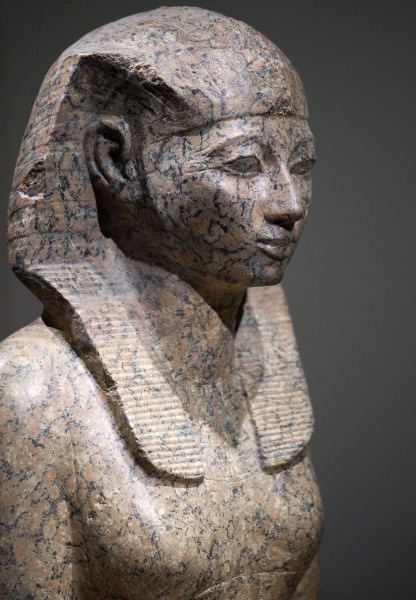
Portrait of Queen Hatshepsut
The position of God's Wife of Amun at Thebes began as an honorary title for a woman of the upper class who assisted the high priest in his duties at the Great Temple of Amun at Karnak. The title is first mentioned in the Middle Kingdom (2040-1782 BCE) as an honorific bestowed on a king's wife or daughter. By the time of the New Kingdom, however, a woman holding the title of God's Wife of Amun was powerful enough to dictate policy (though not as powerful as she would become later in the Third Intermediate Period ). Amun was the most popular god at Thebes and, in time, came to be seen as the creator god and king of the gods. In her role as this god's wife, Hatshepsut would have been considered his consort and would have presided over his festivals. This would have essentially elevated her to the status of a divine being in that it would have been her role to sing and dance for the god at the beginning of festivals to arouse him for the creative act; by engaging directly with the god, she would have taken on an elevated status. The details of exact duties of the God's Wife of Amun are unclear but it is certain that it was a very powerful office which would only become more so later in Egypt's history.
Hatshepsut and Thutmose II had a daughter, Neferu-Ra, while Thutmose II fathered a son with his lesser wife Isis. This son was Thutmose III who was named his father's successor. Thutmose II died while Thutmose III was still a child and so Hatshepsut became regent, controlling the affairs of state until he came of age. In the seventh year of her regency, though, she changed the rules and had herself crowned pharaoh of Egypt. She took on all the royal titles and names which she had inscribed using the feminine grammatical form but had herself depicted as a male pharaoh. Van de Mieroop writes:
Whereas she had been represented as a woman in earlier statues and relief sculptures, after her coronation as king she appeared with male dress and gradually became represented with male physique. Her breasts did not show and she stood in a traditional man's posture rather than a woman's. Some reliefs were even re-carved to adjust her representation to appear more like a man (172).
Her statuary showed her in all her royal grandeur in the forefront with Thutmose III rendered on a smaller scale behind or below her to indicate his lower status. She still referred to her stepson as the king but he was so in name only. Hatshepsut clearly felt she had as much right to rule Egypt as any man and her depiction in art stressed this. Historians Bob Brier and Hoyt Hobbs comment on this:
Her male garb was not intended to fool the citizens into believing their pharaoh was male. Statues unequivocally portray a female, whose sex, in any case, would have been obvious to any Egyptian from her name, "She is First Among Noble Women". Rather than denying her femininity, she was proclaiming that she was also a pharaoh, an office that traditionally had been held by a man (30).
Recognizing that she was in uncharted waters, Hatshepsut took steps to legitimize her reign quickly. If her position as pharaoh were to be challenged, she was not going to allow herself to simply disappear.
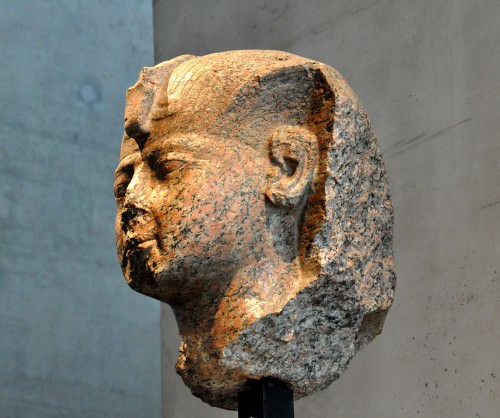
Head of Hatshepsut
THE EARLY REIGN OF HATSHEPSUT
Hatshepsut began her reign by marrying her daughter to Thutmose III and bestowing on Neferu-Ra the position of God's Wife of Amun in order to secure her position. Even if she were now forced to relinquish power to Thutmose III she would still be in a strong position as his step-mother and mother-in-law and, further, she had her daughter in one of the most prestigious and powerful positions in the land. These precautions were not enough, however, and she legitimized her reign by presenting herself not merely as Amun's wife in ritual but as his daughter. She claimed that Amun had appeared to her mother in the form of Thutmose I and conceived her, thus making her a demi-goddess. Her inscription relates the night of her conception as her mother lay in bed:
He [Amun] in the incarnation of the Majesty of her husband, the King of Upper and Lower Egypt, [Thutmose I] found her sleeping in the beauty of her palace. She awoke at the divine fragrance and turned towards his Majesty. He went to her immediately, he was aroused by her he imposed his desire upon her. He allowed her to see him in his form of a god and she rejoiced at the sight of his beauty after he had come before her. His love passed into her body. The palace was flooded with divine fragrance (van de Mieroop, 173).
She furthered her legitimacy through reliefs on public buildings showing Thutmose I making her his co-ruler, claiming that Amun had earlier sent an oracle predicting her rise to power, and linking herself to the expulsion of the Hyksos some 80 years before. The Hyksos were a Semitic people who established themselves at Avaris in Lower Egypt and gradually assumed enough power to control the region. They were defeated and driven from Egypt by Ahmose of Thebes (c. 1570-1544 BCE) which initiated the period of the New Kingdom. The later Egyptian historians regularly characterized the Hyksos (referred to as Asiatics) as hated tyrants who invaded Egypt, sacked temples, and desecrated shrines. Even though these claims were all either exaggerations or untruths, the Egyptian memory of the hated Hyksos was strong and Hatshepsut made good use of that. One of her inscriptions reads:
I have restored what was destroyed. I have raised up what had been shattered, since the Asiatics were in the Delta at Avaris, when the nomads among them were overturning what had been made. They ruled without the god Ra and did not act by divine decree right down to my Majaesty's time (van de Mieroop, 145).
IN KEEPING WITH TRADITION, HATSHEPSUT SET ABOUT COMMISSIONING BUILDING PROJECTS, SUCH AS HER TEMPLE AT DEIR EL-BAHRI, & SENDING OUT MILITARY EXPEDITIONS.
She presented herself as a direct successor to Ahmose, whose name the people still remembered as their great liberator, in order to further strengthen her position and defend against detractors who would claim a woman was unfit to rule. Her numerous inscriptions, monuments, and temples all demonstrate how unprecedented her reign was: no woman before her had ruled the country openly as pharaoh.
PHARAOH HATSHEPSUT
In keeping with tradition, Hatshepsut set about commissioning building projects, such as her temple at Deir el-Bahri, and sending out military expeditions. The exact nature of the military campaigns is unclear but their objectives were the regions of Syria and Nubia. It is likely that the campaigns were launched simply to uphold the tradition of pharaoh as a warrior-king bringing wealth into the land through conquest, could have been seen as a continuation of Thutmose I's campaigns in those regions (further legitimizing her position), or could have been fairly provoked. The pharaohs of the New Kingdom, the age of empire, placed great emphasis on keeping secure buffer zones around the country to avoid a repeat of what they saw as the "invasion" of the Hyksos.
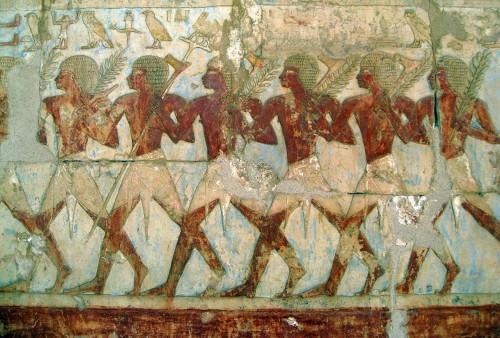
Egyptian Soldiers
In all her projects, campaigns, and policies she relied on the advice and support of one of her courtiers, a man named Senenmut, whose relationship with the queen remains mysterious. Van de Mieroop notes that, "he was a man of undistinguished birth who rose to prominence at court. Several statues show him holding princess Neferu-Ra whose mentor and steward he became before Hatshepsut's accession" (174-175). He was in charge of all of Hatshepsut's grandest projects including her famous temple at Deir el-Bahri.
Hatshepsut's greatest efforts went into these building projects which not only elevated her name and honored the gods but employed the people. The scope and size of Hatshepsut's constructions, as well as their elegant beauty, attest to a very prosperous reign. None of her projects could have been completed as they were if she were not in command of a wealth of resources. Egyptologist Betsy M. Bryan writes:
As ruler, Hatshepsut inaugurated building projects that far out-stripped those of her predecessors. The list of sites touched by Thutmose I and II was expanded in Upper Egypt to include places that the Ahmosid rulers had favoured: Kom Ombo, Nekhen (Hierakonopolis), and Elkab in particular, but also Armant and Elephantine...However, no site received more attention from Hatshepsut than Thebes. The temple of Karnak grew once more under her supervision with the construction work being directed by a number of officials...With the country evidently at peace during most of the twenty years of her reign, Hatshepsut was able to exploit the wealth of Egypt's natural resources, as well as those of Nubia. Gold flowed in from the eastern deserts and the south: the precious stone quarries were in operation, Bebel el-Silsila began to be worked in earnest for sandstone, cedar was imported from the Levant, and ebony came from Africa (by way of Punt, perhaps). In the inscriptions of the queen and her officials, the monuments and the materials used to make them were specifically detailed at some length. Clearly Hatshepsut was pleased with the amount and variety of luxury goods that she could acquire and donate in Amun's honour; so much so that she had a scene carved at Deir el-Bahri to show the quantity of exotic goods brought from Punt (Shaw, 229-231).
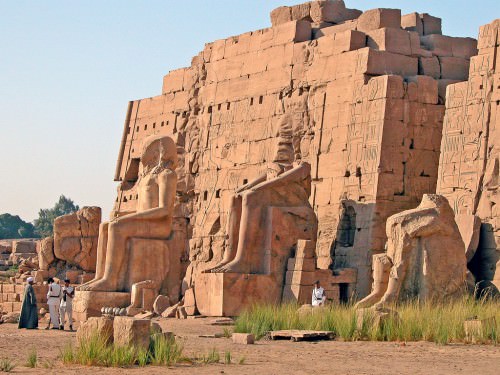
Hatshepsut's Temple, Karnak
Hatshepsut's expedition to Punt (modern day Somalia) was her crowning achievement in her own eyes. Punt had been a partner in trade since the time of the Middle Kingdom but expeditions there were expensive and time-consuming. That Hatshepsut could launch her own expedition, especially one so lavish, is a testament to how prosperous her reign was. The inscription which accompanies the relief of the expedition, engraved on the walls of her temple at Deir el-Bahri, describes the luxury goods in detail:
The loading of the ships very heavily with marvels of the country of Punt; all goodly fragant woods of God's Land, heaps of myrrh-resin, with fresh myrrh trees, with ebony and pure ivory, with green gold of Emu, with cinnamon wood, Khesyt wood, with Ihmut-incense, sonter-incense, eye cosmetic, with apes, monkeys, dogs, and with skins of the southern panther. Never was brought the like of this for any king who has been since the beginning (Lewis, 116).
Her temple at Deir el-Bahri remains one of the most impressive and often visited in Egypt. Brier and Hobbs note how "the art produced under her authority was soft and delicate; and she constructed one of the most elegant temples in Egypt against the cliffs outside the Valley of the Kings" (30). Her temple rose from beside the River Nile with a long ramp ascending from a courtyard of trees and small pools to a terrace. Some of these trees were brought from Punt and are the first known successful transplants of trees from one nation to another in history. The remains of these trees, fossilized tree stumps, can still be seen in the courtyard of the temple in the present day. The lower terrace was lined with columns and a ramp led up to a second terrace which was equally impressive. The temple was decorated with statuary, reliefs, and inscriptions with her burialchamber carved out of the cliffs which form the back of the building. Hatshepsut's temple was so admired by the pharaohs who came after her that they increasingly chose to be buried nearby and this necropolis came to eventually be known as the Valley of the Kings.
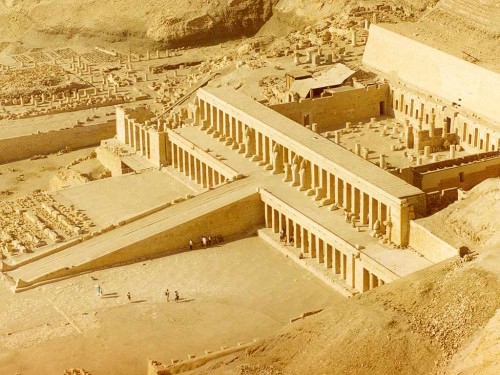
Temple of Hatshepsut
Hatshepsut built on a grander scale than any pharaoh before her and, except for Ramesses II (1279-1213 BCE) none who came after. She had two enormous obelisks raised at Karnak in addition to those elsewhere and, as noted, commissioned building projects throughout the country. So vast were her building projects, in fact, that there are few museums featuring ancient Egyptian art and artifacts in the present day which do not have some piece commissioned by Pharaoh Hatshepsut.
DEATH & DISAPPEARANCE
While Hatshepsut had been ruling the country, Tuthmose III had not been sitting quietly by watching. She gave him command of the armies of Egypt and it has been suggested (most notably by Egyptologist James Henry Breasted) that he survived her reign by proving himself useful to her as a general and, more or less, keeping out of her way.
In c. 1457 BCE Tuthmose III led his armies to put down a rebellion from Kadesh (the famous Battle of Megiddo), a campaign possibly anticipated and commissioned by Hatshepsut, and afterwards her name disappears from the historical record.Thuthmose III back-dated his reign to the death of his father and Hatshepsut's accomplishments as pharaoh were ascribed to him. When and how she died was unknown until recently. Egyptologist Zahi Hawass claimed to have located her mummy in the Cairo museum's holdings in 2006 CE. An examination of that mummy shows that she died in her fifties from an abscess following a tooth extraction.
Tuthmose III went on to become a great pharoah known now as "the Napoleon of Ancient Egypt" for his brilliant military victories. Later in his reign he had all evidence of his step-mother erased from monuments and all evidence of her reign destroyed. Senenmut and Neferu-Ra had both died long before and there was no one at court, it seems, who had the power or inclination to change this policy. The wreckage of some of these works was dumped near her temple at Deir el-Bahri and excavations brought her name to light along with the inscriptions inside the temple which Champollion was so mystified by.Although there have been many theories over the years as to why Tuthmose III tried to blot Hatshepsut's name from history, the most likely reason was that her reign had been unconventional and departed from tradition.
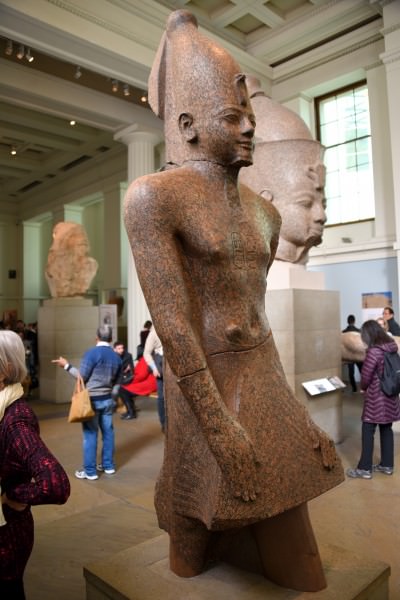
Statue of King Thutmose III
The pharaoh's chief responsibility was the maintenance of ma'at (harmony, balance) and a woman in a man's position would have been seen as disruptive to that balance. The pharaoh served as a role model to his people and it is possible that Tuthmose III feared that other women might look to Hatshepsut for inspiration and try to follow her example, thereby departing from a tradition which maintained that men should rule Egypt and women should be only consorts, as it was in the beginning of time when the god Osiris ruled with his consort Isis. Ancient Egyptian culture was very conservative in many respects and placed no value on change or alteration in tradition. A female pharaoh, no matter how successful her reign, was outside of the accepted understanding of the role of the monarchy and so all memory of that pharaoh had to be erased.
The Egyptian belief that one lives on as long as one's name is remembered, however, is exemplified in Hatshepsut. She was forgotten as the period of the New Kingdom continued and remained so for centuries. Once her name was found again by Champollion in the 19th century CE, and then by others throughout the 20th, she gradually came back to life and assumed her rightful place as one of the greatest pharaohs in Egypt's history.
Osiris › Who Was
Definition and Origins

Osiris is the Egyptian Lord of the Underworld and Judge of the Dead, brother-husband to Isis, and one of the most important gods of ancient Egypt. The name `Osiris' is the Latinized form of the Egyptian Usir which is interpreted as 'powerful' or 'mighty'. He is the first-born of the gods Geb (earth) and Nut (sky) shortly after the creation of the world, was murdered by his younger brother Set, and brought back to life by his sister-wife Isis. This myth, and the gods involved, became central to Egyptian culture and religious life. Osiris was originally a fertility god, possibly from Syria (though this claim is contested) who became so popular he absorbed the function of earlier gods such as Andjeti and Khentiamenti, two gods of fertility and agriculture worshipped at Abydos. He is associated with the djed symbol and is often depicted with black or green skin symbolizing the fertile mud of the Nile and regeneration. He is also frequently shown as a mummy or in partially mummified form in his role as Judge of the Dead.
Images of Osiris as a living god depict him as a handsome man in royal dress wearing the crown of Upper Egypt as a plumed headdress known as the atef and carrying the crook and flail, symbols of kingship. He is associated with the mythical Bennu bird (inspiration for the Greek Phoenix) who rises to life from the ashes. Osiris was known by many names but chiefly as Wennefer, "The Beautiful One" and, in his role as Judge of the Dead, Khentiamenti, "The Foremost of the Westerners". The west was associated with death and 'westerners' became synonymous with those who had passed on to the afterlife.
He was also known as The Lord of Love, King of the Living, and Eternal Lord. After Isis, Osiris was the most popular and enduring of all the Egyptian gods. His worship spanned thousands of years from shortly before the Early Dynastic Period (c. 3150-2613 BCE) to the Ptolemaic Dynasty (323-30 BCE), the last dynasty to rule Egypt before the coming of Rome. It is also possible that Osiris was worshipped in some form in the Predynastic Period of Egypt (c. 6000-3150 BCE) and probable that he originated at that time. Scholar Geraldine Pinch writes:
Where, when, and how Osiris was first worshipped is much disputed. It has been claimed that Osiris was originally a deified Predynastic king, a primitive vegetation spirit, a jackal god of an early royal necropolis, or a mother goddess. Even the etymology of his name is uncertain, though it may simply mean 'The Mighty One' (178).
Although he is usually seen as a just, generous, and giving god of life and abundance there are also depictions of him as "a terrifying figure who dispatches demon-messengers to drag the living into the gloomy realm of the dead" (Pinch, 178) though these are the minority. Osiris as the kind and just ruler, murdered by his resentful brother, who comes back to life is the most popular and enduring image of the god.
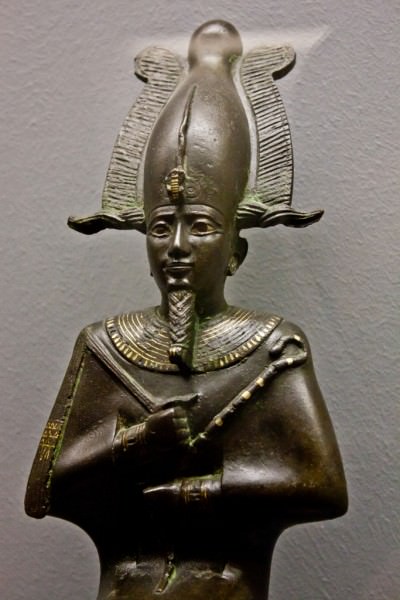
Osiris
THE OSIRIS MYTH
After the creation of the world, the first five gods were born of the union of Geb (earth) and Nut (sky) and these were Osiris, Isis, Set, Nephthys, and Horus. Osiris, as the first born, assumed rule as Lord of the Earth, with Isis as his queen and consort. He found the people of Egypt uncivilized and lawless and so gave them laws, culture, religious instruction, and agriculture. Egypt became a paradise under Osiris' rule where everyone was equal and there was abundant food as the crops were always plentiful. Set was jealous of his brother's success and grew resentful. Their relationship deteriorated further after Nephthys, Set's wife, disguised herself as Isis and seduced Osiris, becoming pregnant with the god Anubis. Set had a beautiful coffin made to Osiris' exact height and then threw a grand party where he presented this box and told the guests that whichever of them fit in it most perfectly could have it as a gift. When Osiris lay down in the coffin, Set slammed the lid on, fastened it shut, and threw it into the Nile, where it was carried away down river.
Osiris' body traveled out to sea and eventually his coffin became lodged in a great tamarisk tree growing near Byblos in Phoenicia. The tree grew quickly around the coffin until it completely contained it. The king of Byblos, Malcander, came to the shore with his wife Astarte and admired the tree and the sweet scent which seemed to emanate from it. He ordered the tree cut down and brought to his palace as an ornamental pillar for the court, and there Osiris remained, trapped inside the coffin within the pillar, until he died.
OSIRIS AS THE KIND AND JUST RULER, MURDERED BY HIS RESENTFUL BROTHER, WHO COMES BACK TO LIFE IS THE MOST POPULAR AND ENDURING IMAGE OF THE GOD.
Isis had meanwhile left Egypt in search of her husband and eventually came to Byblos, disguised as an older woman, where she sat down by the shore and cried for her missing husband. She was invited to the palace by the royal handmaidens who had come to the shore to bathe and there ingratiated herself to the king and queen so she was asked to be nursemaid for their young sons. Isis tried to make the younger boy immortal by bathing him in fire and, when Queen Astarte discovered this, she was horrified. Isis then revealed herself as the goddess and the king and queen promised her anything she wanted if she would only spare them. She requested only the pillar - which they swiftly granted to her.
After leaving the court, Isis cut Osiris from the tree and carried his body back to Egypt where she hid him from Set in the swampy region of the Nile Delta. She left him to go gather herbs to make a potion to return him to life, leaving her sister Nephthys to guard the body. While she was gone, Set learned of his brother's return and went out to find his body. He managed to get Nephthys to tell him where it was, and when he found it, he hacked it into pieces and scattered it across the land and into the Nile. When Isis returned, she was horrified but quickly composed herself and went to work finding the pieces of her murdered husband. With Nephthys' help, she recovered all of the body parts except the penis, which had been thrown into the Nile and eaten by the oxyrhyncus fish, which is why this fish was forbidden food in ancient Egypt.
Isis was able to revive Osiris and, once he was alive, she assumed the form of a kite and flew around him, drew the seed from his body into her own, and became pregnant with a son, Horus. Even though Osiris now lived, he was incomplete and could no longer rule the land of the living. He withdrew into the afterlife where he became Lord and Judge of the Dead. Isis, fearing what Set might do to her son, hid Horus among the swamps of Egypt until he was grown. At that point, Horus emerged as a mighty warrior and battled Set for control of the world. In some versions of the story, Set is killed but, in most, he is defeated and driven from the land. The chaos Set had unleashed on the world was conquered by Horus, who restored order, and then ruled with his mother.
WORSHIP OF OSIRIS
The myth embodied some of the most important values of Egyptian culture: harmony, order, eternal life, and gratitude. Set's resentment of Osiris, even before the affair with Nepthys, grew from a lack of gratitude and an envy for someone else's good fortune. In Egypt, ingratitude was a kind of "gateway sin" which opened the individual up to all others. The story dramatically illustrated how even a god could fall prey to ingratitude and the consequences which could follow. Just as importantly, the myth told the story of the victory of order over chaos and the establishment of harmony in the land; a central value of Egyptian culture and religion.
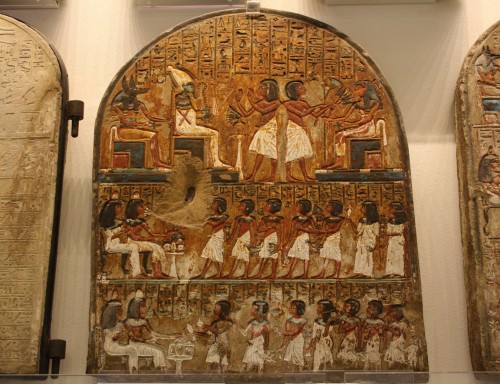
Minhotep & Nakhtmin Relief Stele
Osiris' rebirth was associated with the Nile River, which was considered a symbol of his life-giving power. Osiris' festivals were held to celebrate the beauty of the god and his transcendent power but also his death and rebirth. The festival of the Fall of the Nile commemorated his death while the Djed Pillar Festival celebrated Osiris' resurrection. Historian Margaret Bunson writes:
As the Nile receeded, the Egyptians went to the shore to bestow gifts and to show grief over Osiris' dying another time. The Nile represented Osiris' capacity to renew the earth and to restore life to the nation. When the Nile began its steady rise toward the flood stage, Osiris was again honored. Small shrines were cast adrift on the river, and priests poured sweet water into the Nile, declaring that Osiris was found again (198).
The city of Abydos was his cult center and the necropolis there became the most sought-after burial ground as people wanted to be buried as close to the god as they could get. Those who lived too far away or did not have the resources for such a burial had a stele erected there with their name on it. Osiris was most widely worshipped as Judge of the Dead but the 'dead' continued to exist in another realm and death was not the end of one's existence. The festivals, therefore, celebrated life - both on earth and afterwards - and part of these celebrations was the planting of an Osiris Garden which was a garden bed molded in the shape of the god and fertilized by the mud and water of the Nile. The grains which would later grow symbolized Osiris rising from the dead and also the promise of eternal life for the one who tended the garden.
Osiris Gardens were placed in tombs where they are known as an Osiris' Bed. Margaret Bunson describes this practice, writing :
These were boxes fashioned out of wood or pottery normally in the shape of the god. Osiris' Beds were often hollow, planted with Nile mud and corn. The boxes were then wrapped as mummies and placed in the tomb.The corn was expected to sprout as a symbol of Osiris' resurrection. Some boxes did contain actual evidence of growth when they were unwrapped centuries later (198).
Priests of Osiris tended the temple and statue of the god at Abydos, Busiris, and Heliopolis and, as was customary with Egyptian worship, the priests alone were allowed into the inner sanctum. The people of Egypt were invited to visit the temple complex to make offerings and ask for prayers, seek medical advice and counsel, receive aid from the priests by way of material goods or financial gifts, and leave sacrifices to the god in asking for a favor or by way of thanking the god for a request granted.
OSIRIS, THE KING, & THE PEOPLE
Osiris was considered the first king of Egypt who established the cultural values all later kings were sworn to uphold. When Set murdered the king, the country plunged into chaos and order was only restored with the victory of Horus over Set. The kings of Egypt identified with Horus during life (they each had a personal name and a 'Horus Name' they took at the beginning of their reign) and with Osiris in death. As Isis was the mother of Horus, she was considered the mother of every king, the king was her son, and Osiris was both their father and their higher aspect and hope of salvation after death.
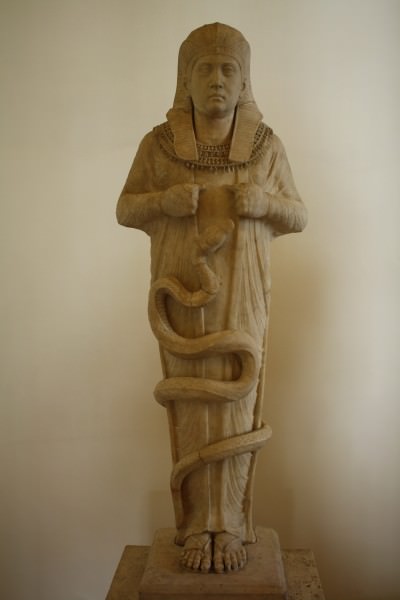
Osiris
It is for this reason that Osiris is so often depicted as a mummified pharaoh ; because pharaohs were mummified to resemble Osiris. The image of the great mummified god preceeded the practice of preparing the royal body to look like Osiris. All the Egyptian symbols and images which made up the Pyramid Texts on the walls of tombs were meant to remind the soul of the deceased what to do next once they arrived in the afterlife. Their appearance as Osiris himself would not only remind them of the god but also would drive away dark spirits by fooling them into thinking one was the great god himself. The king's appearance as modeled after Osiris' extended throughout his reign; the famous flail and shepherd's staff, synonymous with Egyptian pharaohs, were first Osiris' symbols as the flail represented the fertility of his land while the crook symbolized the authority of his rule.
OSIRIS WAS THE ALL-MERCIFUL, THE FORGIVING, & THE JUST JUDGE OF THE DEAD WHO OVERSAW ONE'S LIFE ON EARTH & IN THE AFTERLIFE.
Harmony and order had been established by the son of Osiris, Horus, and the king was Horus' living representative who provided for the needs of the people. Osiris was credited with establishing both the kingship and the natural order and law of life and so, through one's participation in one's community and observance of rituals, one was following Osiris' guidelines. The people, as well as royalty, expected the protection of Osiris in life and his impartial judgment after death. Osiris was the all-merciful, the forgiving, and the just judge of the dead who oversaw one's life on earth and in the afterlife.
THE MYSTERIES OF OSIRIS
Osiris' identification with eternal life, with life from death, gave rise to his mystery cult which would travel beyond the boundaries of Egypt as the Cult of Isis. Although no one knows what rituals were involved in the mystery cult of Isis, they may have developed from Osiris' earlier mysteries celebrated at Abydos beginning in the Twelfth Dynasty (1991-1802 BCE). These were very popular festivals which drew people from all over Egypt to participate in the ritual. Bunson notes that "the mysteries recounted the life, death, mummification, resurrection, and ascension of Osiris" (198). Dramas were staged with the major roles given to prominent members of the community and the local priests who enacted the story of the Osiris myth.
The story known as The Contention Between Horus and Set was then acted out in mock battles between The Followers of Horus and The Followers of Set where it seems anyone could participate. Once the battle had been won by the followers of Horus, the people celebrated the restoration of order and the golden statue of Osiris was brought forth from the inner sanctum of the temple and carried among the people who lavished gifts upon the image. The statue was carried through the city in a circuit and finally placed in an outdoor shrine where he could be admired by his people and also participate fully in the festivities. The emergence of the god from the darkness of his temple to participation in the joys of the living symbolized Osiris' return to life from death.
Although this festival was primarily held at Abydos, it was also celebrated at other cult centers dedicated to Osiris throughout Egypt such as Bubastis (which was another very important cult center), Busiris, Memphis, and Thebes. Osiris, of course, was the central figure of these celebrations but, in time, the focus shifted to his wife, Isis, who had actually saved him from death and returned him to life. Osiris was intimately tied to the Nile River and the Nile River Valley of Egypt but Isis eventually became detached from any given locality and was considered the Queen of Heaven and the creator of the universe. All other Egyptian gods were finally seen as aspects of the mighy Isis and in this form her cult traveled to Greece, to Phoenicia, to Rome and throughout the Roman Empire.
The Cult of Isis was so popular in the Roman world that it outlasted every other pagan belief system once Christianity took hold of the popular imagination. The most profound aspects of Christianity, in fact, can be traced back to the worship of Osiris and the Cult of Isis which grew from his story. In ancient Egypt, as in the modern day, people needed to believe that there was a purpose to their lives, that death was not the end, and that some kind of supernatural being cared for them and would protect them. The worship of the great god Osiris provided for that need just as people's religious beliefs do today.
LICENSE:
Article based on information obtained from these sources:with permission from the Website Ancient History Encyclopedia
Content is available under License Creative Commons: Attribution-NonCommercial-ShareAlike 3.0 Unported. CC-BY-NC-SA License